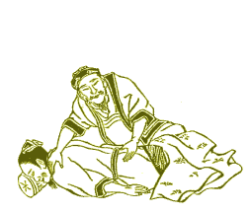Shiatsu
 Overview
Overview
Shiatsu is a Japanese massage technique moaning "finger pressure." It is based on principles found in Traditional Chinese Medicine, or TCM. Shiatsu encourages a steady flow of Qi in order to correct imbalances and allow the improvement of one's overall health. Practitioners believe shiatsu alleviates many different types of health problems.
Description
Developed in the early twentieth century, Shiatsu became widely known in the West in the 1970s. Health care practitioners who utilize Shiatsu apply pressure using the palms, fingers, elbows, forearms and even feet to various pressure points (which the Japanese call tsubos) along the patient's body.
Doing this allows the proper flow of life energy, or Qi. Shiatsu is recommended to be practiced even while one is healthy, making it more of a preventative practice. Shiatsu is also used to relieve pain, to improve mental function and to alleviate a wide range of ailments including digestive problems, chronic stress, and lower back pain.
History of Shiatsu
The use of massage and body work for improving disease and curing health has its origins in ancient China. Dating back to the legendary reign of the Yellow Emperor in China from 2697 to 2595 bce, massage is one of the treatment principles of TCM. While the basic tenets of TCM were not written down until sometime between 213 bce and 240 ce, most researchers believe the practices were passed down from generation to generation for thousands of years.
These TCM practices spread throughout Asia and made their way to Japan around 500 to 6-00 bce. The word "massage" became known as "amma," whose literal translation is "rubdown." By the early 1900s amma was still being practiced in Japan as a curative, but had become more well-known for it s affiliations with relaxation, pleasure and sensuality.
Because of this change in status, those practitioners who wanted to continue using massage as a means of therapy began calling their practice Shiatsu. Those therapists worked to raise public awareness of the healing powers of massage. In today's Japan, Shiatsu is still one of the most popular forms of massage.
Health Benefits of Shiatsu
Shiatsu is thought of as a "holistic" form of bodywork, meaning the mind and body are viewed as connected to each other and to one's entire environment. Shiatsu practitioners believe that the Qi, or life energy, surrounds and penetrates one's physical body. They believe Qi flows through the body via invisible channels they call meridians.
The practitioners of Shiatsu are trained to manipulate the pressure points that lie along these meridians in order to balance the patient's energy. According to TCM, illness or disease (including psychological or emotional problems) is the result of an imbalance in the person's Qi. The Shiatsu therapist can help a patient maintain or improve his or her health by balancing and fortifying the life energy.
If illness or disease is already present, Shiatsu is used to encourage the body's self-healing process.
Conditions Benefited by Shiatsu
This type of massage has been known to alleviate many different conditions, including:
- Asthma
- Arthritis
- Circulation problems
- Digestive disorders
- Headaches
- Insomnia
- Menstrual problems
- Musculoskeletal problems
- Stress
- Tiredness
Shiatsu promotes deep relaxation and its proponents claim it regulates the hormonal system and the circulation of blood and lymphatic fluids. Practitioners also claim that regular Shiatsu sessions help prevent illness. Shiatsu is said to aid in one's emtional stability, help promote self-confidence and peace of mind, and alleviates circulatory problems.
Finding a Therapist
When searching for a Shiatsu therapist, it may be wise to seek help from a national organization.
At the initial Shiatsu session, the therapist will give a diagnosis according to the "four examinations" typical of TCM treatments. One does not have to undress for this diagnosis, but a single layer of cotton garments would be a good choice of attire.
The patient lies on a mat or on the floor for the treatment and each session addressed the whole body. To begin, the palms and fingertips are used by the practitioner to search out problem areas in the body. Thumbs and fingertips are used for the applying of specific pressure to a pressure point. Otherwise, the palms tend to be used for the massage. When very strong pressure needs to be applied, the elbows, feet and knees may also be used.
A typical session lasts for about an hour.
Dangers and Limitations
Shiatsu is not recommended for people who have the following conditions:
- Epilepsy
- High blood pressure
- Osteoporosis
- Thrombosis
- Varicose veins
- Cancer
It is also best to avoid Shiatsu treatments if pregnant. Avoid these treatments if the person is known to suffer from brittle bones or is taking cortisone medications, which weaken the bones. People who are under the influence of alcohol, have a contagious disease or have a fever should also temporarily refrain from receiving Shiatsu treatments.
Do not eat or exert oneself with strenuous exercise for at least one hour before a Shiatsu session.
References
- Bratman, S. (1998). The Alternative Medicine Ratings Guide: an expert panel rates the best treatments for over 80 conditions. New York: Crown Publishing Group
- Brown, L. (1999). Alternative Medicine. London : Teach Yourself
- Deepak Chopra, M.D. (2002). Alternative Medicine: The Definitive Guide. Puyallup, Wash. : Future Medicine Pub.
Posted in Shiatsu
Ask a Question Or Join a Discussion


